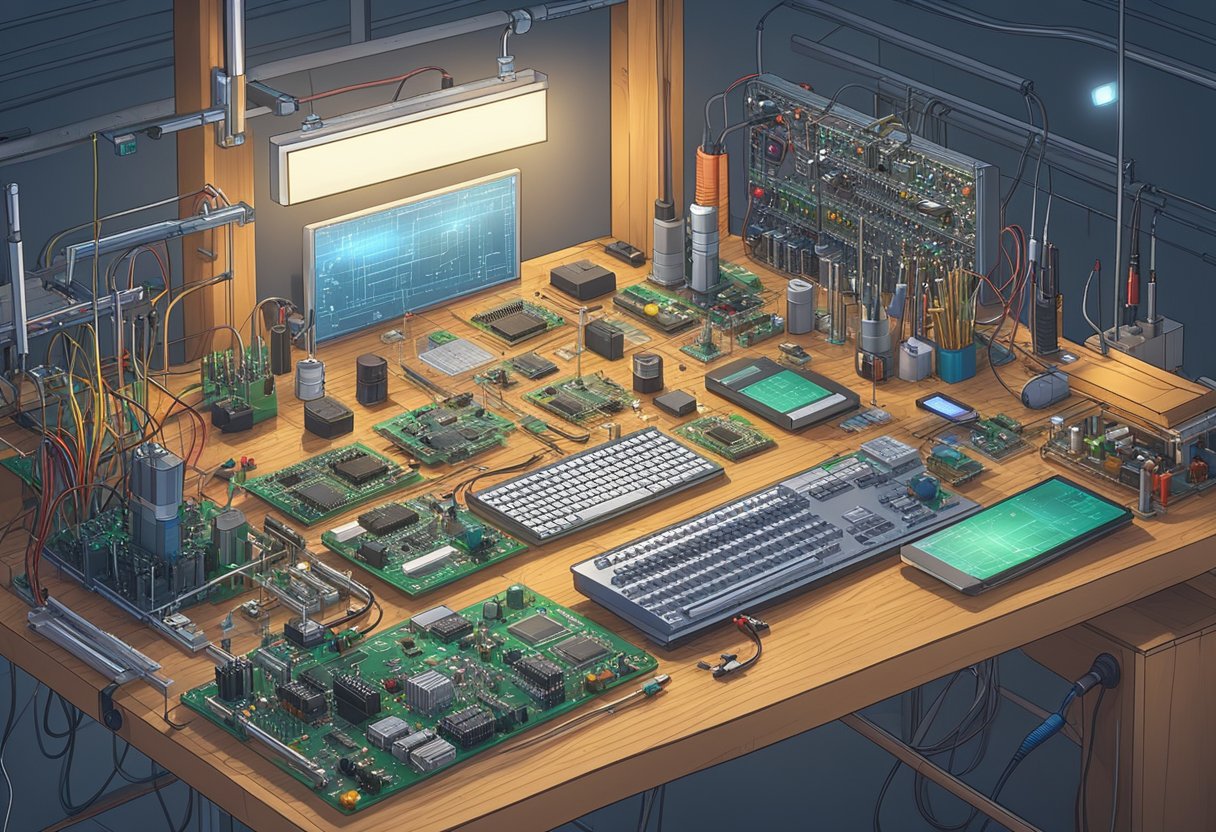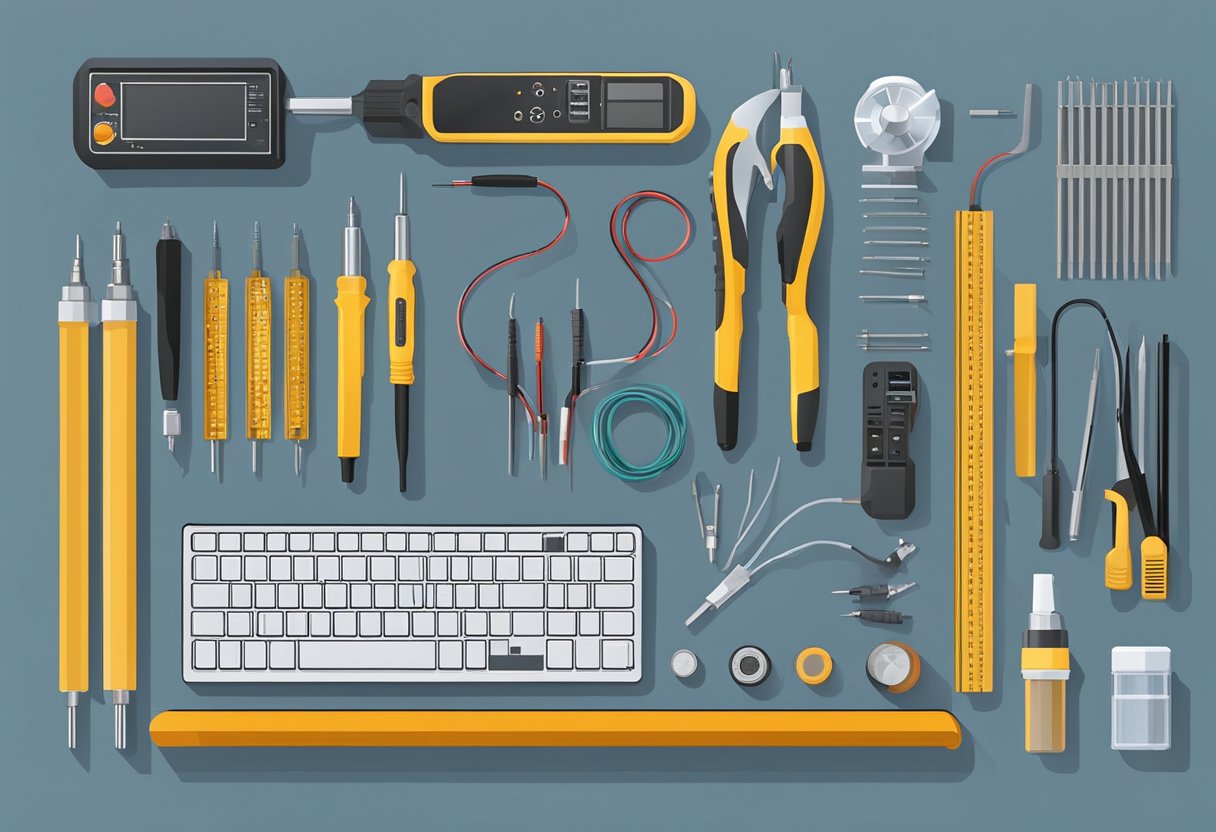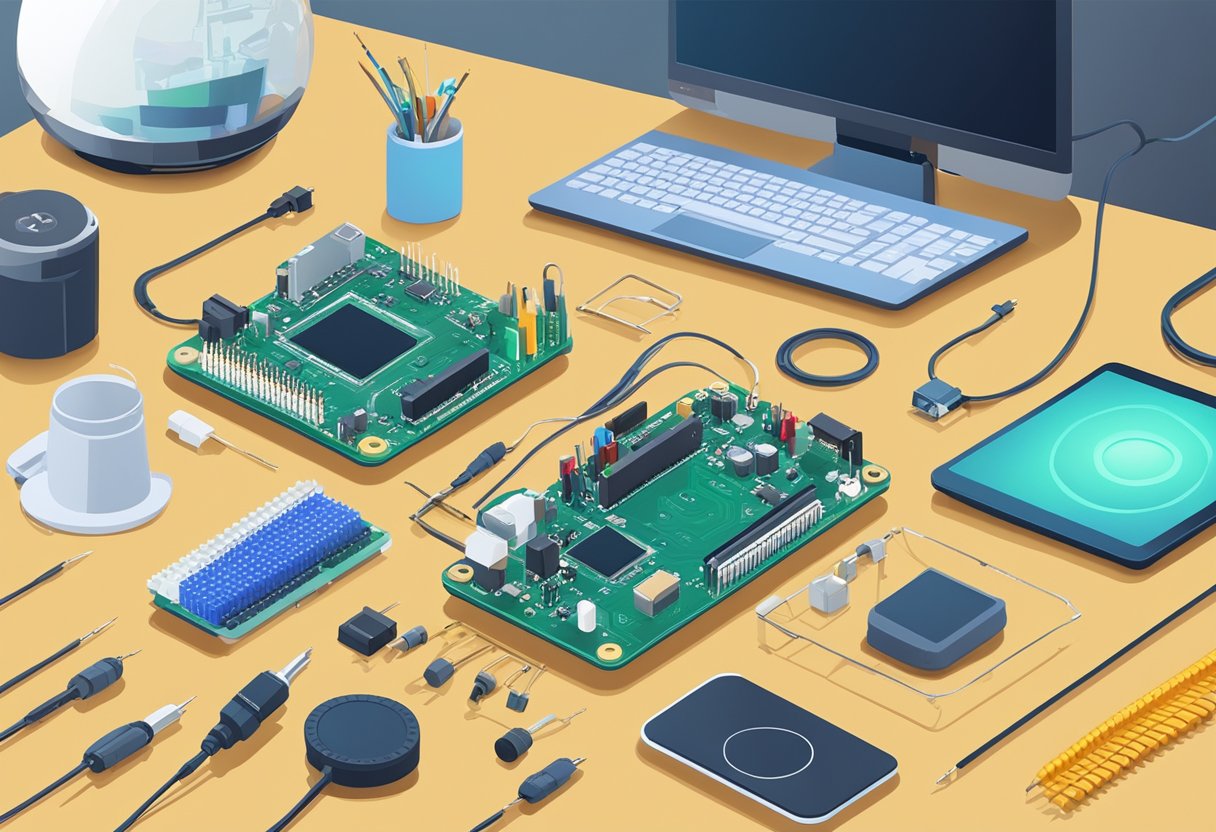How to Build an IoT Project: A Step-by-Step Guide for Beginners
Building an Internet of Things (IoT) project can be an exciting journey into the world of technology. Understanding the essentials of IoT and properly planning the project is crucial for success. With countless applications ranging from smart home devices to industrial automation, the possibilities are nearly endless.

To get started, it is important to know the key components needed for the design and development of IoT devices. This includes hardware selection, software integration, and ensuring reliable connectivity. By breaking down the project into manageable parts, developers can streamline their efforts and make informed choices.
As the IoT landscape continues to evolve, keeping security and data protection in mind will help create more resilient solutions. Engaging with the right resources and tools enhances the learning experience and encourages innovation in the IoT space.
Key Takeaways
- Proper planning is essential for a successful IoT project.
- Selecting the right hardware and software is crucial for connectivity.
- Security measures should always be a priority in IoT development.
Understanding the Basics of IoT
The Internet of Things (IoT) is a network of devices that connect and communicate with each other. Understanding its main components and significance is crucial for anyone looking to build an IoT project.
Defining IoT and Its Significance
The Internet of Things refers to a system where everyday objects are connected to the internet. This connectivity allows these objects to send and receive data.
IoT is significant because it enhances efficiency, enables automation, and provides real-time insights. Businesses can monitor their operations closely. For example, a smart thermostat can adjust temperatures based on user preferences, leading to energy savings.
Moreover, IoT can improve safety. Sensors in vehicles can warn drivers of potential hazards. This technology transforms how we live and work, creating smarter environments.
Key Components of IoT Systems
Several key components make up an IoT system. These include IoT devices, sensors, connectivity, and IoT platforms.
-
IoT Devices: These are physical objects equipped with software and sensors, such as smart home gadgets or industrial sensors.
-
Sensors: Sensors collect data from the environment. For instance, temperature sensors can monitor climates in different settings.
-
Connectivity: Devices need to communicate, often using Wi-Fi, Bluetooth, or cellular networks.
-
IoT Platforms: These platforms are essential for managing and analyzing data collected from devices. They help developers build applications and ensure data security.
Each component plays a vital role, allowing for a seamless flow of information within an IoT ecosystem.
Planning Your IoT Project

Effective planning is crucial for a successful IoT project. It involves setting clear objectives, choosing the right platforms, and ensuring a good user experience while keeping future growth in mind.
Outlining Goals and Objectives
Before starting, it is important to outline specific goals. These goals should address real business problems. By identifying objectives, the project team can stay focused on what matters most.
Use the SMART criteria for goal-setting:
- Specific: Define the issue clearly.
- Measurable: Set metrics to track progress.
- Achievable: Ensure the goals are realistic.
- Relevant: Align with the broader IoT strategy.
- Time-bound: Set deadlines for accountability.
Clearly defined objectives guide the development process and help evaluate success.
Selecting the Right IoT Platform
The choice of an IoT platform is fundamental to the project’s success. The right platform should support the needed functionalities and integrate well with existing systems.
Key considerations include:
- Connectivity Options: Ensure it supports necessary protocols.
- Data Management: Look for robust data analytics features.
- Security: Prioritize platforms with strong security measures.
Additionally, assess scalability. The platform should accommodate future growth, allowing the addition of more devices and features without major changes.
Considering User Experience and Scalability
User experience plays a vital role in the acceptance of an IoT solution. It’s important to design with the end-user in mind. Intuitive interfaces lead to higher satisfaction and usage rates.
Gather feedback through usability testing. This helps identify areas for improvement. Furthermore, scalability should be a priority. As the project grows, it must handle increased data and device loads effortlessly.
Focus on both user needs and potential growth to create a lasting and effective IoT deployment.
Designing IoT Hardware

Designing IoT hardware involves careful selection of components and expertise in microcontrollers. It also requires planning for future growth and scalability. Attention to these areas helps ensure the project’s success and efficiency.
Choosing Hardware Components
Selecting the right hardware components is crucial for any IoT project. One should consider factors such as cost, availability, and compatibility. Common components include sensors, actuators, and communication modules.
- Sensors: Devices that capture data from the environment, such as temperature and humidity sensors.
- Actuators: These components perform actions based on data received, like motors or lights.
- Communication Modules: Essential for data transmission, options include Wi-Fi, Bluetooth, and LoRa.
This selection directly impacts the functionality and efficiency of the project.
Microcontrollers and Development Boards
Microcontrollers serve as the brain of the IoT device. They process inputs from sensors and control actuators. Popular options include Arduino and Raspberry Pi, each suited for different tasks.
- Arduino: Ideal for simple, low-power projects. It has a straightforward programming interface and ample libraries for various sensors.
- Raspberry Pi: More powerful, suitable for complex applications requiring higher processing. It runs an operating system, supporting more extensive software.
Choosing the right microcontroller depends on the complexity and requirements of the project.
Ensuring Hardware Scalability
Scalability is vital for future growth. When designing, one must plan how the hardware can adapt to more devices or increased data traffic.
A few key considerations include:
- Modularity: Using modular components allows for easy upgrades and replacements.
- Connectivity Options: Implementing multiple connectivity methods can accommodate more devices.
- Data Management: Efficient data handling ensures that as the system grows, it remains responsive.
By planning for scalability, one can enhance the longevity and effectiveness of the IoT system.
Developing IoT Software
Developing software for IoT projects requires careful planning and the right tools. Key areas to focus on include programming languages, cloud storage solutions, data analytics, and the integration of machine learning. Understanding these components is essential for creating effective IoT applications.
Selecting a Suitable Programming Language
Choosing the right programming language is critical for IoT software development. Common languages include:
- Python: Great for rapid development and data analysis.
- JavaScript: Excellent for real-time web applications.
- C/C++: Suitable for low-level programming and system-level applications.
The choice depends on the specific requirements of the project. For example, C/C++ is preferred for hardware interfacing, while Python is ideal for data manipulation. Each language has libraries and frameworks that can enhance development. Developers should consider the development environment as well, opting for integrated development environments (IDEs) that support collaboration and version control.
Utilizing Cloud Storage and Data Analytics
Cloud storage is essential for IoT projects as it offers scalability and accessibility. Services like AWS, Google Cloud, and Microsoft Azure provide robust options for storing data generated by IoT devices.
Data analytics can transform this raw data into meaningful insights. Tools such as Apache Hadoop or Spark can process large sets of data efficiently. Analytics can help in:
- Monitoring device performance
- Predicting maintenance needs
- Enhancing user experience
Developers should focus on implementing data pipelines to ensure efficient data flow. Using cloud services also allows for easy integration with machine learning models, making it possible to apply analytics in real time.
Integrating IoT with Machine Learning
Integrating machine learning into IoT applications adds significant value by enabling predictive capabilities. Machine learning algorithms can analyze data from IoT devices to make informed decisions.
Key steps include:
- Data Collection: Gather data from devices to train models.
- Model Selection: Choose appropriate algorithms, such as regression or classification methods.
- Real-Time Processing: Use platforms like TensorFlow or PyTorch for real-time analysis.
Machine learning can improve device functionality. For instance, smart thermostats learn user preferences to optimize energy use. Developers should ensure that models are continually updated with new data for ongoing enhancement of the system’s accuracy and efficiency.
Ensuring Connectivity and Communication
Connectivity is crucial for IoT projects as it enables devices to communicate effectively. Choosing the right networking options and protocols ensures seamless data exchange. The following sections outline important considerations for establishing reliable communication.
Networking and Protocols
Networking is a key part of IoT development. A solid network ensures devices can send and receive data reliably. Common protocols include Wi-Fi, Bluetooth, and various cellular networks.
- Wi-Fi offers fast data rates and is widely available. It works best for devices that have access to electrical power.
- Bluetooth is suitable for short-range communication and is energy-efficient, making it ideal for battery-powered devices.
- Cellular networks are great for devices that need to operate over larger distances but may incur higher operational costs.
Each option has strengths and weaknesses. The choice depends on the specific needs of the project.
Wi-Fi vs. Bluetooth vs. Network Coverage
When deciding between Wi-Fi and Bluetooth, consider usage scenarios and coverage area.
- Wi-Fi supports high-speed data transfer and can cover large areas, making it suitable for home automation systems or smart cities.
- Bluetooth is limited in range, but its low power consumption is ideal for wearable devices or small sensors.
Network coverage is also a factor. In rural areas, cellular networks might be necessary for reliable connectivity. Urban settings may provide better Wi-Fi options with more hotspots available to devices.
Utilizing MQTT and HTTP for IoT
Protocols like MQTT and HTTP are essential for data transmission in IoT projects.
- MQTT (Message Queuing Telemetry Transport) is lightweight and designed for low bandwidth. It’s perfect for devices that need to send small amounts of data regularly.
- HTTP (HyperText Transfer Protocol) is commonly used for web communications but can be heavier, making it less efficient for devices with limited resources.
Choosing between MQTT and HTTP impacts both performance and power consumption. Understanding these protocols helps developers optimize their IoT applications for better efficiency and reliability.
Implementing IoT Software Platforms
Implementing software platforms is a crucial step in building an IoT project. It involves integrating tools and frameworks that ensure efficient communication and management of devices. Key elements include Node-RED for workflow automation and ROS for robotic systems, alongside effective telemetry and device management strategies.
Introduction to Node-RED and ROS
Node-RED is a powerful tool for visual programming, ideal for connecting devices and APIs. It offers a browser-based flow editor, allowing users to wire together devices, services, and online APIs. This visual approach helps simplify complex interactions, making it easier to manage workflows.
Robot Operating System (ROS) is another vital platform, especially in robotics. While it’s not an operating system per se, it provides a collection of tools and libraries to help software developers build robot applications. ROS supports hardware abstraction, device drivers, and message-passing, which are essential for developing complex robotic systems.
Implementing Device Management
Device management involves monitoring and maintaining IoT devices throughout their lifecycle. Effective systems ensure that devices are secured, updated, and configured properly.
Key tasks in device management include:
- Provisioning: Setting up devices to connect to networks securely.
- Monitoring: Tracking device performance and status in real-time.
- Updating: Applying software updates and patches to maintain security and functionality.
Using platforms like AWS IoT or Google Cloud IoT can streamline these processes, automating many aspects of device management with dashboards and alerts.
Setting Up a Web Server and Telemetry
Setting up a web server is essential for data communication in IoT projects. The server acts as a central point for data storage and processing. Popular choices include Apache, Nginx, and Node.js for their efficiency and ease of use.
Telemetry is the collection and transmission of data from remote devices. This data can include sensor readings, GPS coordinates, and device health metrics. To implement telemetry effectively, developers must focus on:
- Data Formats: Using JSON or XML for easy data exchange.
- Protocols: Selecting suitable communication protocols like MQTT or HTTP for reliable transmission.
With a proper web server and telemetry setup, IoT devices can send real-time data, enabling better decision-making and enhanced system functionality.
IoT Security and Data Protection
In an IoT project, security is crucial to protect devices, data, and networks. Understanding the specific risks, implementing effective testing methods, and following best practices helps ensure robust security measures.
Understanding IoT Security Risks
IoT devices face unique security risks. These include:
-
Unauthorized Access: Hackers may gain access to devices and networks, compromising data and functionality.
-
Data Breaches: Sensitive information collected by IoT devices can be exposed if proper security is lacking.
-
Device Manipulation: Attackers can alter device settings, leading to misuse or malfunction.
Many IoT devices have limited processing power, making it challenging to implement strong security features. Early design stages should include a risk analysis to identify vulnerabilities. By anticipating these threats, developers can create resilient systems tailored to each device’s specific needs. For instance, devices requiring remote access should use strong authentication methods and encryption to protect data in transit.
Applying Penetration Testing
Penetration testing is a proactive approach to security. It involves simulating attacks to identify weaknesses in the IoT system.
-
Identify Vulnerabilities: By testing devices and networks, issues can be found before they are exploited.
-
Assess Security Levels: Checking how current security measures hold up against potential attacks reveals areas for improvement.
Penetration testers use various tools to evaluate the system. The results guide necessary enhancements to strengthen security. Regular testing is essential, especially after updates or new deployments. This process keeps security measures effective against evolving threats.
IoT Security Best Practices
Adhering to best practices helps solidify IoT security. Key practices include:
-
Secure Device Design: Build security into devices from the start, rather than adding it later. This involves thorough planning and risk assessment.
-
Regular Software Updates: Ensure that device firmware and software are consistently updated to protect against known vulnerabilities.
-
Data Encryption: Encrypting data both in transit and at rest helps protect sensitive information from unauthorized access.
-
Strong Authentication: Implement robust authentication methods, such as multi-factor authentication, for user access.
By focusing on these best practices, developers can significantly reduce the risks to IoT systems, ensuring safer and more reliable technology.
Applications of IoT
IoT technology has various practical uses that improve efficiency and convenience. From monitoring the environment to enhancing home living, IoT applications cater to both personal and industrial needs.
Environmental Monitoring and Smart Thermostat
Environmental monitoring is crucial for managing climate change and energy consumption. IoT devices can track air quality, temperature, and humidity in real time. This data helps communities respond to pollution and temperature changes.
Smart thermostats are an essential part of this category. They allow users to control heating and cooling systems remotely. Features like learning user preferences and optimizing energy usage contribute to energy savings. For instance, a smart thermostat can adjust the temperature based on occupancy, reducing waste.
Asset Tracking and Home Automation
Asset tracking uses IoT sensors to locate and monitor valuable items. Businesses utilize these devices to prevent loss and improve inventory management. For example, RFID tags can track packages during shipping, ensuring they reach their destination efficiently.
Home automation simplifies daily tasks. IoT devices control lights, appliances, and security systems. Homeowners can manage these systems through smartphones or voice commands, enhancing security and energy efficiency. Integrated systems send alerts for unusual activity, improving safety.
Industrial Applications and Preventative Maintenance
Industries leverage IoT for various applications, such as equipment monitoring and predictive maintenance. Sensors on machines collect performance data, helping gauge wear and tear. This allows for timely repairs before the equipment fails.
Preventative maintenance helps reduce downtime and repair costs. By analyzing data, companies can schedule maintenance before issues arise. This proactive approach increases productivity and extends the lifespan of machinery.
Optimizing and Maintaining Your IoT Project

To ensure an IoT project runs smoothly, it is essential to focus on continuous monitoring, effective management of devices, and creating lasting value. These areas not only enhance performance but also help in adapting to changes over time.
Monitoring and Compliance Reporting
Monitoring the performance of IoT devices is crucial. It involves tracking data flow, connectivity, and functionality. Regular checks help identify issues before they escalate, ensuring the system operates efficiently.
Compliance reporting is another key component. It ensures that the IoT system adheres to industry regulations and standards. This process includes documenting data access and usage, which is important for maintaining user trust and security.
To streamline monitoring and compliance, consider using tools and platforms that provide real-time insights and automated reporting features.
Ongoing Device Management
Effective device management is vital for an IoT project’s success. This includes tasks such as software updates, security patches, and performance tuning. Keeping devices updated minimizes vulnerabilities and improves functionality.
Additionally, regular audits of devices can help ensure they are working correctly. This involves checking battery life, data storage capacity, and overall health. Creating a schedule for routine maintenance helps avoid unexpected downtime.
Engaging a skilled team or outsourcing to an IoT service provider can enhance device management efforts, allowing for timely interventions and updates.
Creating Recurring Value with IoT
To create lasting value with IoT implementations, focus on data analysis. By analyzing the data collected, organizations can derive actionable insights that lead to process improvements and innovation.
Establishing a feedback loop is important. For instance, user interactions and sensor data can guide future developments. Investing in advanced analytics tools enables the transformation of raw data into meaningful strategies.
In addition, keep end-users engaged by regularly updating software and adding new features. This keeps the service relevant and encourages user loyalty.
Frequently Asked Questions
Building an IoT project involves several steps and considerations. Understanding the components, processes, and best practices is key for anyone looking to dive into IoT.
What are the essential steps to build an IoT project?
The first step is to define a specific use case. This helps to clarify the project’s goals. Next, researchers should develop a clear plan, including technology selection and budget. Prototyping and testing are crucial for refining the design before full-scale development.
What components are needed to develop an IoT device?
An IoT device typically requires sensors, microcontrollers, and communication modules. Power sources, such as batteries or solar panels, are also necessary. Additionally, cloud services for data storage and processing may be needed to analyze and manage the collected data.
How can one create an IoT application for beginners?
Beginners can start by using development platforms like Arduino or Raspberry Pi. These platforms offer user-friendly interfaces and resources for building simple applications. Tutorials and online courses can provide step-by-step instructions on building and integrating IoT applications.
Can you provide examples of successful IoT project implementations?
Successful implementations include smart home devices that automate lighting and security. Industrial IoT projects monitor equipment performance to improve maintenance. Agriculture IoT solutions help farmers track soil conditions to optimize crop yields. These examples illustrate diverse applications across various industries.
What are the best practices for IoT device design?
Designing for reliability and security is vital. Ensure that devices can handle various operating conditions and threats. Regular software updates for security and functionality are important. User-centered design helps create intuitive interfaces that enhance user experience.
What are the prerequisites for starting an IoT project?
A basic understanding of electronics and programming is beneficial before starting. Familiarity with networking concepts helps in understanding device communication. Resources such as tutorials, development kits, and online communities can provide essential support and guidance during the initial stages.






Post Comment